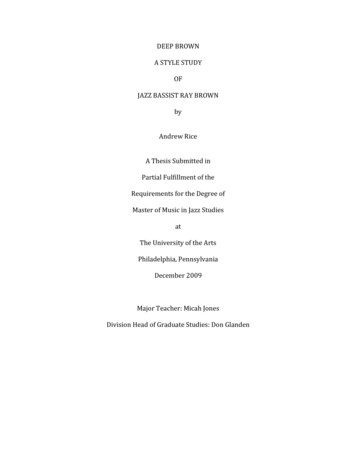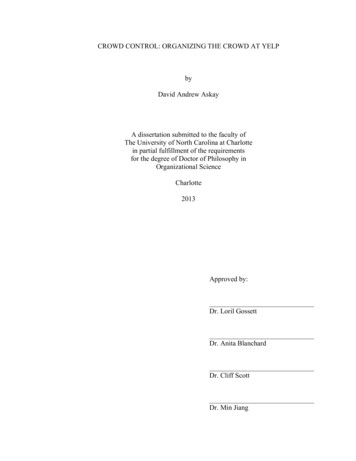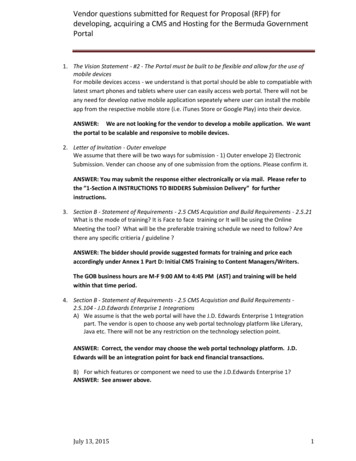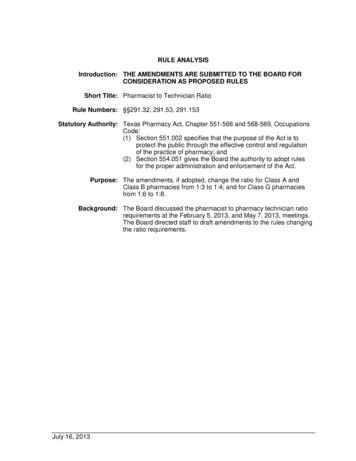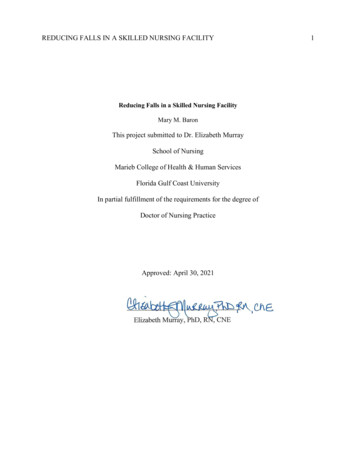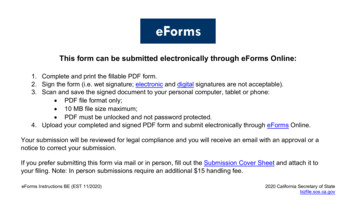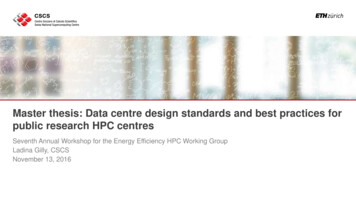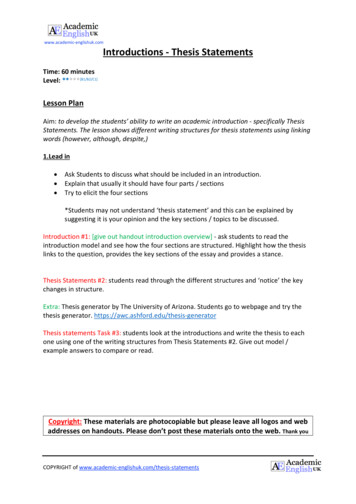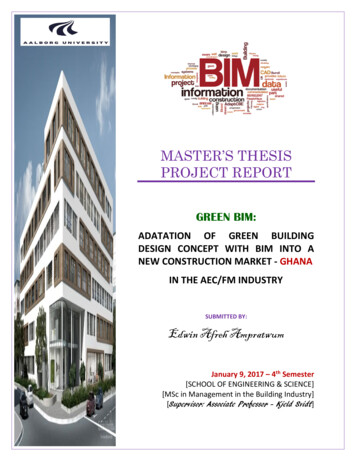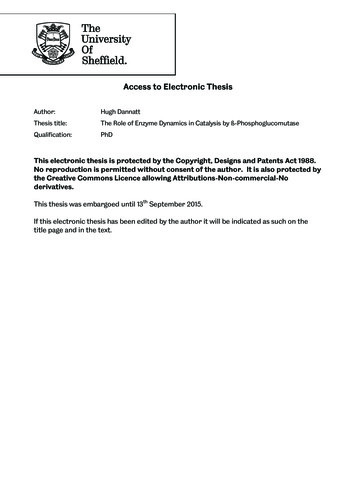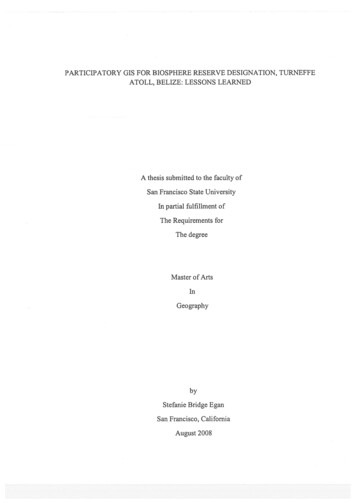
Transcription
PARTICIPATORY GIS FOR BIOSPHERE RESERVE DESIGNATION, TURNEFFEATOLL, BELIZE: LESSONS LEARNEDA thesis submitted to the faculty ofSan Francisco State UniversityIn partial fulfillment ofThe Requirements forThe degreeMaster of ArtsInGeographybyStefanie Bridge EganSan Francisco, CaliforniaAugust 2008
TABLE OF CONTENTSINTRODUCTION.ERROR! BOOKMARK NOT DEFINED.STUDY AREA AND BACKGROUNDERROR! BOOKMARK NOT DEFINED.HISTORYERROR! BOOKMARK NOT DEFINED.LITERATURE REVIEWERROR! BOOKMARK NOT DEFINED.INTEGRATED COASTAL ZONE MANAGEMENTBiosphere ReservesIntegration and Public Participation GISMETHODSDATA COLLECTIONMap Creation and DataRESULTS AND DISCUSSIONMAP RESULTSData mining and GJS layer ResultsInterview ResultsCONCLUSIONS AND RECOMMENDATIONSERROR! BOOKMARK NOT DEFJNED.Error! Bookmark itot defined.Error! Bookmark not defined.ERROR! BOOKMARK NOT DEFINED.ERROR! BOOKMARK NOT DEFINED.Error! Bookmark not defined.ERROR! BOOKMARK NOT DEFINED.ERROR! BOOKMARK NOT DEFINED.Error! Bookmark not defined.Error! Bookmark not defined.ERROR! BOOKMARK NOT DEFINED.
Participatory GIS for Biosphere Reserve Zone Designation, Turneffe Atoll, Belize:Lessons LearnedIntroductionThis paper discusses the development of a public participation geographic informationsystem (PGIS) to contribute to the designation of a biosphere reserve for Turneffe Atoll,Belize.Public participation is the engagement of a group or group of stakeholders with aninterest in a particular project. A public participation endeavor is one that incorporatestheir interests, perspectives and concerns with the hope that the final outcome be one thatis supported by the stakeholders. The amount of participation can range from providingfeedback to actual participation in the creation andlor management of a project.A geographic information system is a database that stores geographic and attribute data inlayers and allows the user to view various layers simultaneously. This allows for flexible,multi-scenario data analysis. Further, it can be continually updated as new data iscollected.Turneffe Atoll is an extremely rich ecosystem consisting of extensive mangrove forests,coral reefs and abundant wildlife, some endemic to the Atoll. Tumeffe currently has fewresource protections. The Atoll is a popular location with both commercial andrecreational fishers as well as recreational divers. As Turneffe Atoll’s attributes becomeincreasingly well-known, it is imperative that a comprehensive resource managementplan be put into place to both protect and sustain its biota.Page 1
Participatory GIS for Biosphere Reserve Zone Designation, Turneffe Atoll, Belize:Lessons LearnedA biosphere reserve designation effort is currently underway for the Atoll in an effort toremedy this lack of a full-scale system of resource protection. More than just a protectedarea, however, a biosphere reserve aims to integrate scientific study, resource use andenjoyment with protection, to ultimately achieve a balanced and sustainable resourcemanagement plan.The development of a PGIS for Turneffe is an effort to capture, in one location, theexisting resource data about the atoll with the knowledge of the stakeholders of the atoll.By informing the stakeholders about the biosphere effort for Tumeffe, and collectingimportant data from them, the project intended to create a participatory database whiletrying to help further consensus for the protection effort. The maps from this project willserve as an aid in the biosphere reserve designation process.Conducting research for a master’s thesis is a big undertaking and time commitment. Thework can be even more challenging when the site of the research is in a developingcountry, such as Belize, with the potential for language and cultural differences as well asother possibly unanticipated hurdles. The two years I have spent working on my projecthave taught me, through trial and error, what I should have been anticipating prior tobeginning my work.Now nearing the completion of my work, I can look at the issues I faced and see how Icould have minimized these from the outset through better awareness and preparation.My work in Belize has taught me that there needs to be a good understanding of the timeframe involved in any project; that it is essential to have contacts in the country inPage 2
Participatory GIS for Biosphere Reserve Zone Designation, Turneffe Atoll, Belize:Lessons Learnedquestion that can facilitate relationship-building; and that there be a clear understandingof one’s role in and goals for the project at hand.Study Area and Background:Turneffe Atoll is located 25 miles east of Belize City and is the largest of the threeBelizean Atolls (Holguin 2006, Gischler and Hudson 199 ) (Map 1). It is composed of agroup of cayes (some greater than 5000 acres) surrounded by a coral reef. The reefs ofTumeffe are part of the larger Mesoamerican Reef system, the second largest reef in theworld, and the largest in the Atlantic OceanTumeffe Atoll measures approximately 30 miles long and 10 miles wide. The cayes arecomposed of dense mangrove forest representing over 10% of the total mangrove coverin Belize (McField 2005), which together with the coral and seagrass, providessubstantial spawning grounds for fish.Page 3
Participatory GIS for Biosphere Reserve Zone Designation, Turneffe Atoll, Belize:Lessons Learned7 ’4)1:1An/)Punta’GordiMap I Beliza and Atolls. Source: www.greendragonbeIize.comhmaesImap belizegifTurneffe is home to threatened, endangered and endemic species such as the Americansaltwater crocodile ( Crocodvius acutus), the Antillean manatee (TrichecusNassau grouper (Epinephelusinsularis)striatus)manatus),theas well as the Belize Atoll gecko (Phvllodactytusand the white-spotted toadfish (Sanopus astrtfer), the latter two believed to beendemic to the three atolls of Belize (McField 2005). The Atoll is a nesting site for bothsea birds and a number of sea turtle species.Page 4
Participatory GIS for Biosphere Reserve Zone Designation, Tumeffe Atoll, Belize:Lessons LearnedTurneffe is a significant recreational and commercial fishing site. In addition tocommercial fish species, both conch and lobster are commercially harvested here. TheAtoll is also a popular destination for bonefishing and scuba diving (Turneffe IslandDevelopment Guidelines www.tumeffe.comlpdf/TIDG-FINAL.pdf). Currently, there isno significant conservation management system in place, although it has been identifiedby both the country of Belize and the Nature Conservancy as an area that should be ofhigh priority for conservation in the Caribbean (McField 2005).There are three diving/recreational fishing lodges on the Atoll, with more slated fordevelopment (check to see if this has changed). In addition, dive boats bring divers andtourists into the waters around Tumeffe from neighboring areas, such as Belize City andSan Pedro (Tumeffe Island Development Guidelines nd). A runway was built on theAtoll in 2006(confirm date), signaling its rapidly growing importance as a touristdestination. In addition to the diving lodges, the University of Belize has a researchfacility, the Institute of Marine Studies, on Calabash Caye, and the Oceanic Society, anon-governmental organization (NGO), runs a research and ecotourism facility onBlackbird Caye.HistoryRecognizing the economic and biological importance of the coastal zone, and the needfor sustainable development, the Government of Belize established a Coastal ZoneManagement Unit in 1990, later becoming the Coastal Zone Management Project.Sustainable development refers to the careful development of an area such that it is ablePage 5
Participatory GIS for Biosphere Reserve Zone Designation. Turneffe Atoll, Belize:Lessons Learnedto provide for both the current needs of the inhabitants of the area, while also ensuring itslong-term health and productivity. The Coastal Zone management bill, drafted in 1998,called for the establishment of the Coastal Zone Management Authority and Institute(CZMAI) in the same year, designed to oversee the management of the coastal zone(Gardiner and Harbome 2000).The 1990 Guidelines for Developing a Coastal Zone Management Plan for Betize calledfor the systematic compilation of data on the coastal areas, with specific reference to GIScreation, which would enable “spatial and temporal updating” (Price eta!. 1990, pg. 9).Early resource mapping comparing sensitive environmental areas with those of highresource use provided an overview of areas of “resource use conflict” (Price et a!. 1990).The Atolls of Belize were identified as areas of significant resource use conflict, and assuch, in need of resource management efforts.The Coastal Zone Management Authority and Institute produced a Coastal ZoneManagement Strategy in 2001 which called for the creation of Coastal AdvisoryCommittees to be established for all of the coastal areas of Belize. As a result, theTumeffe Islands Coastal Advisory Committee (TICAC) was formed to act asrepresentative of the stakeholders of the Atoll and to bring to CZMAI’s attentionbiological, social, economic and other significant issues. In addition, TICAC is chargedwith developing means of improving the above conditions on the Atoll. In 2001, a draftIsland Management Plan was ordered drawn up for the Atoll. The draft ManagementPlan, recognizing the significant biological and economic importance of Tumeffe,proscribed the designation of the Atoll as either a World Heritage Site, a BiospherePage 6
Participatory GIS for Biosphere Reserve Zone Designation, Tumeffe Atoll, Belize:Lessons LearnedReserve or a Ramsar Convention Site in order to provide protection for the uniqueecosystem and to establish a system of sustainable development for Turneffe. TICACdetermined (check on this) that a Biosphere Reserve, a United Nations designation,would be the best fit for Tumeffe, and in July of 2001, the organization began discussionand exploration of the Biosphere Reserve application process.In 2003, the Oceanic Society, a TICAC member, retained Professor Ellen Hines fromSan Francisco State University and myself to create a public participation GIS for theAtoll. Along with the GIS creation, I was to collect resource data and work with localstakeholders to produce maps of the resources and structures of the Atoll to be includedwith the biosphere reserve application for Tumeffe. The final GIS maps were to bereviewed by TICAC, which would designate the necessary Biosphere Reserve zones. Iwas to digitize this final zone map and provide it for inclusion in the Biosphere Reserveapplication to be submitted to the National Biosphere Reserve committee.As mentioned previously, the country of Belize recognized the increasing pressures onthe coastal zone and the need to proactively provide for this region’s sustainabledevelopment in order that it continue to provide critical ecological and economicfunctions. Specifically, TICAC recognized that any sustainable development program forTumeffe needed to integrate environmental concerns with the economic needs of thosewho depend on the Atoll, and that the effort needed to include input from the Atoll’sstakeholders. As such, the PGIS project for Turneffe was intended to be part of anintegrated coastal zone management (ICZM) approach for the sustainable development ofthe Atoll.Page 7
Participatory GIS for Biosphere Reserve Zone Designation, Turneffe Atoll, Belize:Lessons LearnedLiterature ReviewIntegrated Coastal Zone ManagementCurrent thinking about the sustainable development of coastal zones holds that for longterm success, humans must be an integral part of the conservation process (Jameson et al.2002). Integrated Coastal Zone Management (ICZM) is a management approach thatworks to achieve sustainable development and conservation that is integrated across arange of scales and management approaches (Dutton and Saenger 1994). In looking athow to sustainably develop and manage a coastal area, ICZM takes into considerationcultural and historical uses of the area as well as any conflicting perspectives that mightbe present (Davos 199 ). ICZM does not prescribe specific types of models or solutionsfor achieving these ends, rather an integrated coastal management approach attempts tocreate a conservation program tailored to the cultural, political, historical and ecologicalenvironment of a given area. An ICZM program often results in the creation of a marineprotected area (MPA), or marine reserve; a conservation strategy that allows for the typeof management flexibility as described above (ref).Successful integrated coastal management must provide for the integration of differingviewpoints and interests (Davos 1998). A fully integrated approach to coastal planning isnot an easy prescription, however, as the differing viewpoints may be conflicting.Further, one stakeholder group, no matter how pivotal, cannot be treated individually, fora broad community effort is needed to ensure long term conservation success. There areoften significant connections between user groups and stakeholders that haveimplications for coastal resource management (‘White and Vogt 2000).Page 8
Participatory GIS for Biosphere Reserve Zone Designation, Turneffe Atoll, Belize:Lessons LearnedAs Farnsworth and Ellison (1997) succinctly point out, the effort must be both top-downand bottom-up to be successful. Non-integrated approaches, such as that described byKirkman & Kirkman (2000), are illustrative of the problems that can occur. In their studyof seagrass management in Southeast Asia and Australia, the authors conclude thatmarine reserves that were designated without the input and involvement of local fishershave failed to produce expected results. Restrictions on resource use to protect the longterm viability of a marine/coastal area (or any natural area) must be supported by thelocals. If local resource users feel that their needs and perspectives were considered inthe decision making process and the policies set forth by the reserve, it is more likely thatthey will abide by the regulations (Jameson et at. 2002). In addition, resource users mustrealize some benefits right away if the conservation project is going to retain their support(White and Vogt 2000). Comparisons of baseline resource data with those of current datafrom a reserve can help illustrate the positive impacts of a reserve. It is important that theresource users of a conservation area be able to experience the benefits first-hand,however, to ensure their ongoing support of a project (White and Vogt 2000).Once management guidelines and protections have been established, enforcement of andcooperation with the area’s usage rules must be secured. The successful enforcement ofan area’s resource use restrictions is often related to the buy-in by local stakeholders.Enforcement of extraction and use laws receives more support when there is a solidunderstanding among the local users and stakeholders of the economic benefits ofprotection and effective long-term resource management (White and Vogt 2000).Page 9
Participatory GIS for Biosphere Reserve Zone Designation, Turneffe Atoll, Belize:Lessons LearnedApo Island, Phillipines, discussed by White & Vogt (2000), is a testament to the positiveoutcome that can be achieved with community involvement. The Apo Island MarineReserve effort enjoyed both strong institutional and community support and involvement(Jameson et at. 2002). Silliman University, located in the Phillipines, helped establish acommunity-based marine management system in Apo to be overseen by the local fishingcommunity. The creation of a series of marine reserves and sanctuaries providesprotection for the reefs and fish of the island. Areas within the sanctuary are designatedas no-take fishing zones and are strictly enforced by the community; the reserves allowfor fish extraction but under specified guidelines designed to protect fish yields and thehealth of the coral (White & Vogt 2000).One of the central reasons for its success is the support of the local resource users, in thiscase, fishers. Since the Apo Island reserve system was established in 1985, fishers haveseen fish yields both increase and stabilize, depending on the species. As a result of theprotections provided to the coral reefs of Apo Island, (10% of the total coral area), thefishers benefited from increased fish yields, SCUBA diving and tourism (Alcala 1998).Further, the protected areas, increasing yields and resulting improved marine health in thearea has resulted in increased revenue captured from the wave of tourists,environmentalists, divers and scientists interested in exploring the revitalized marineenvironment (White & Vogt 2000). The benefits realized by the community of ApoIsland have provided an incentive to maintain and abide by the marine reserve system.Monitoring of the fishing regulations is done by locals, with only mostly token supportfrom area police (White & Vogt 2000).Page 10
Participatory GIS for Biosphere Reserve Zone Designation, Turneffe Atoll, Belize:Lessons LearnedIn the case ofBalayan Bay, Phillipines, which is comprised of the municipalities ofMabini and Tingloy, alternative methods of capturing tourist income, particularly amongex-fishers, has led to improved financial conditions which have paved the way for a moresolid foundation of support for reef conservation (White and Vogt 2000). An increase intourism, development, and the use of destructive fishing methods was causing significantdamage to the fragile coral ecosystem of Balayan Bay. Concerned interests bandedtogether to form a community-based conservation effort comprised of various communitygroups, resort owners, fishers, the Phillipine Tourism Authority, and interests from theMunicipality of Mabini in charge of regulating the coastal area in question (White &Vogt 2000). The group worked to educate all users about pollution and sustainable meansof fishing and diving the reefs. The conservation effort ultimately established a marinereserve and three sanctuaries with enforcement provided by resort owners and fishers(White & Vogt 2000).The Balayan Bay area presented some challenges that were not encountered in ApoIsland, namely the presence of a significant non-resident group of users of differentbackgrounds making communication among stakeholders mote challenging (White &Vogt 2000). Bitterness on the part of some local fishers over having to work with tourisminterests presented an additional hurdle in the management process. Conversely,however, some former fishers now operate simple motorized boats to transport divers,enabling them to capture revenue from tourism, elevating their annual income (White &Vogt 2000). Despite improvements in the management and conservation of the BalayanBay coast and water, according to White & Vogt (2000), work still needs to be done inmany areas before more significant conservation objectives can be reached.Page 11
Participatory GIS for Biosphere Reserve Zone Designation, Tumeftè Atoll, Belize:Lessons LearnedAs mentioned in the example above, the lack of a permanent local resident communitycan require a mote complex coastal management arrangement, as it has implications forboth communication among stakeholders as well as resource management objectives(White and Vogt 2000). If fishers, for example, are ethnically diverse and reside in otherlocalities it can be challenging to coordinate the dissemination of information to thisstakeholder group. Further, differing interests among stakeholders, such as fishers andtourism operations, can present obstacles to coordinated management efforts thusrequiring a very open exchange among user groups.In order to maintain local cooperation and support, Luttinger (1997) recommendsimplementing a long term education program for the stakeholders. Such an effort wouldserve to reiterate and demonstrate the benefits of conservation and sustainabledevelopment practices. Further, she recommends that stakeholders be
create a conservation program tailored to the cultural, political, historical and ecological environment of a given area. An ICZM program often results in the creation of a marine protected area (MPA), or marine reser
